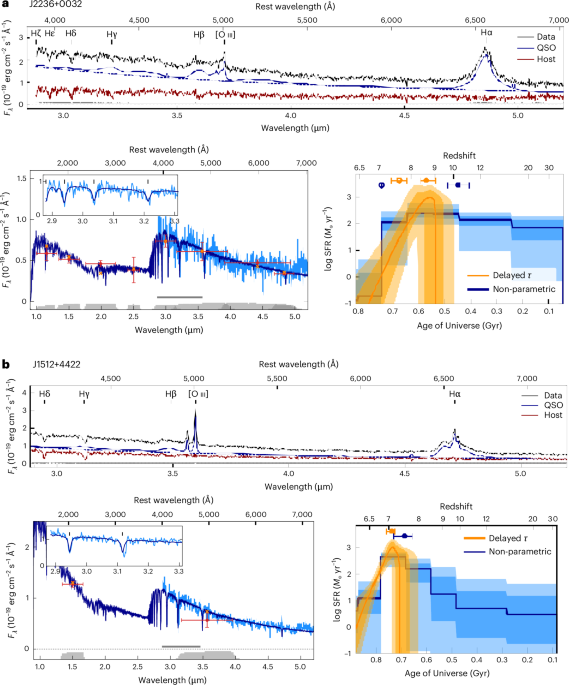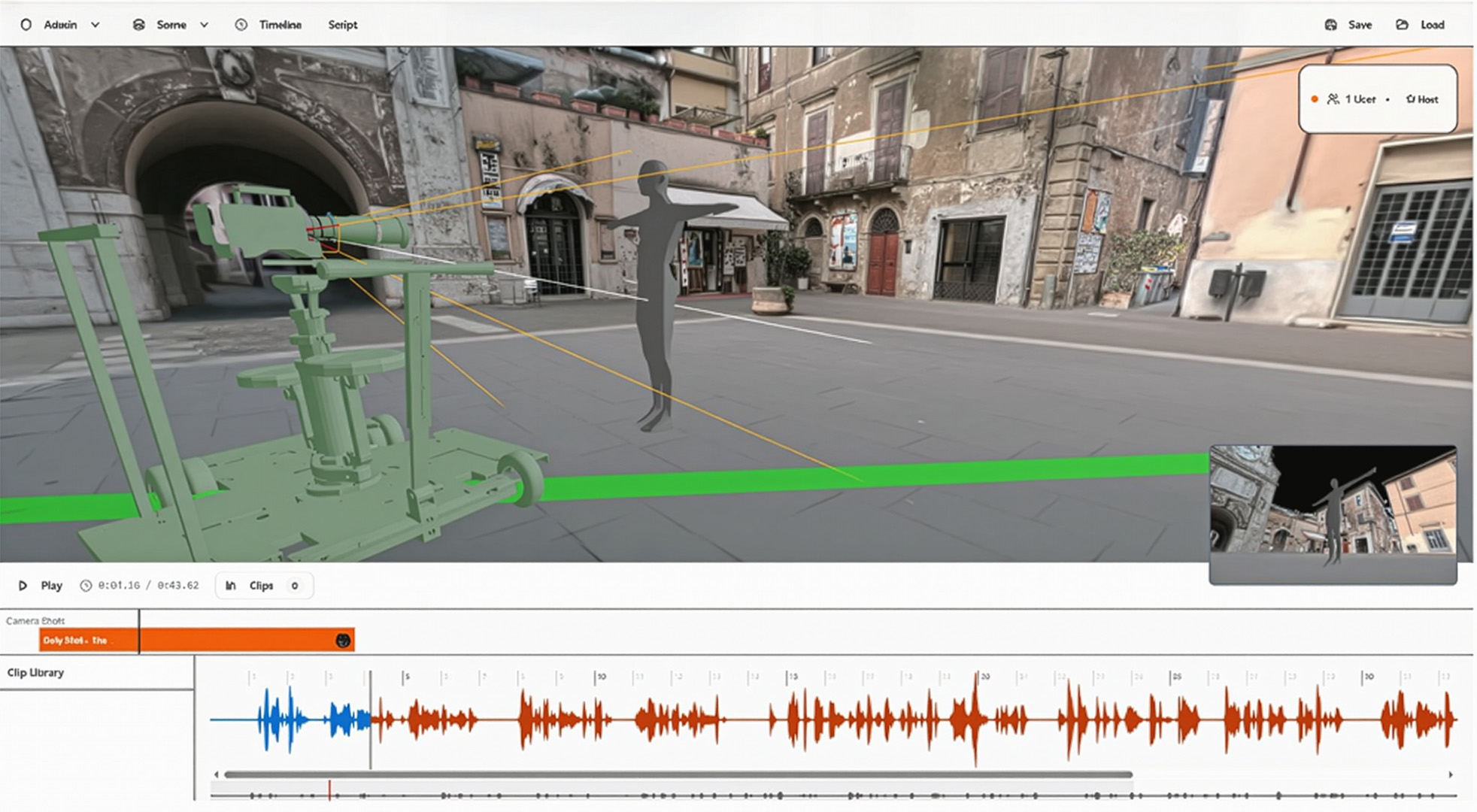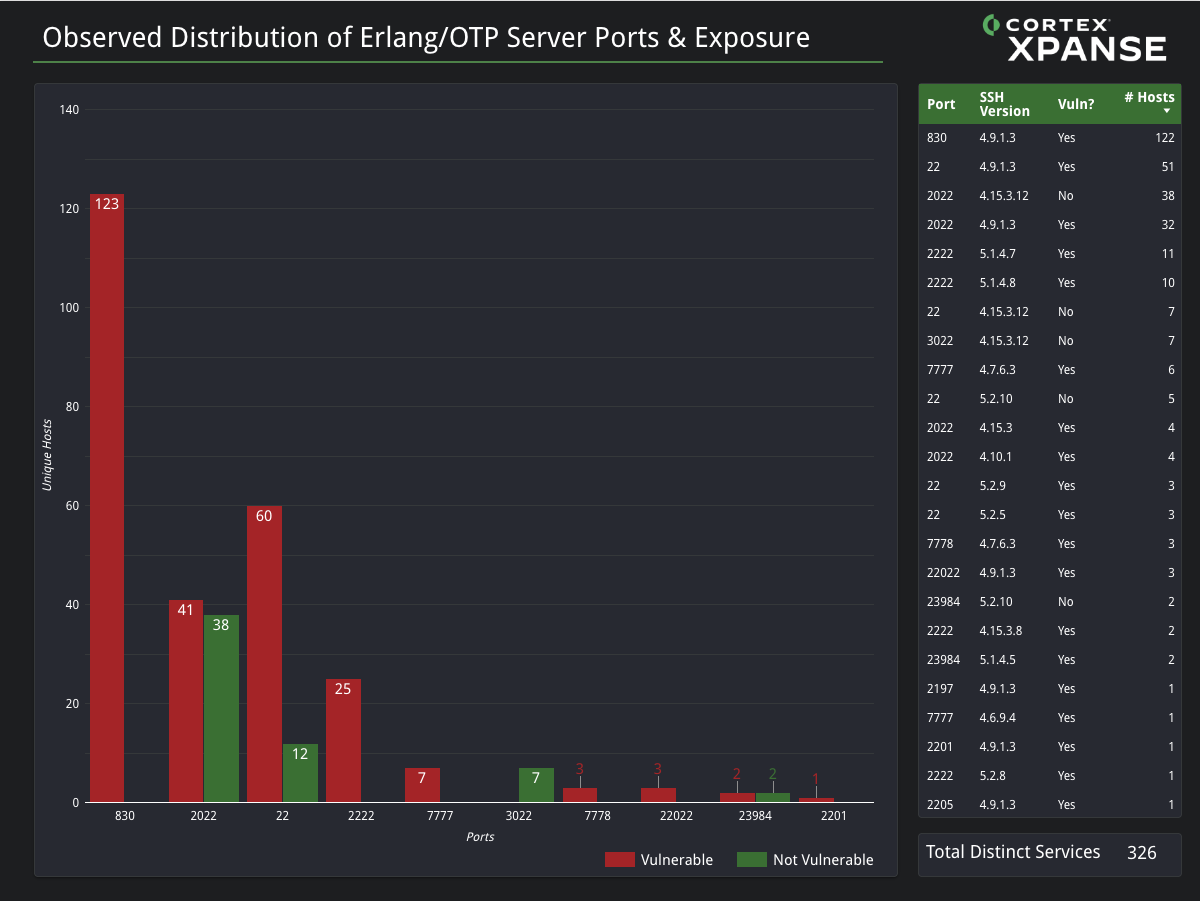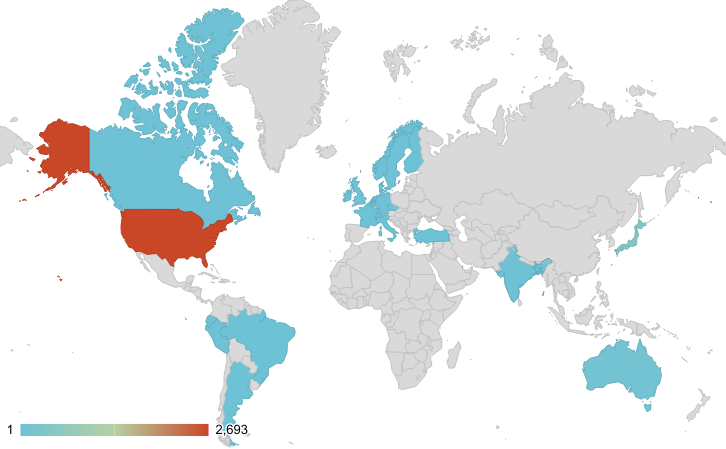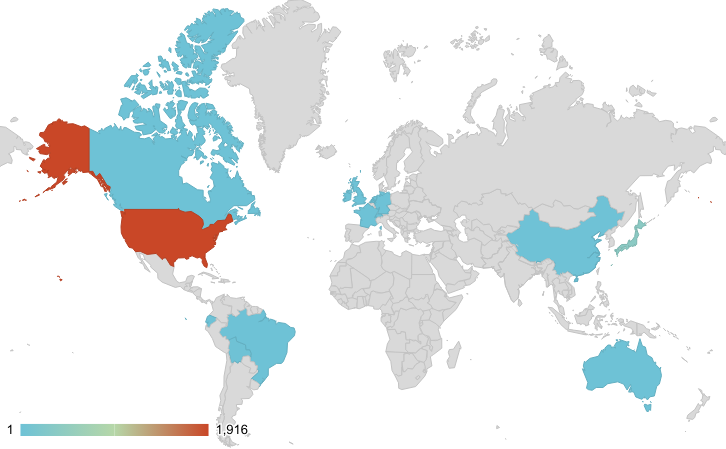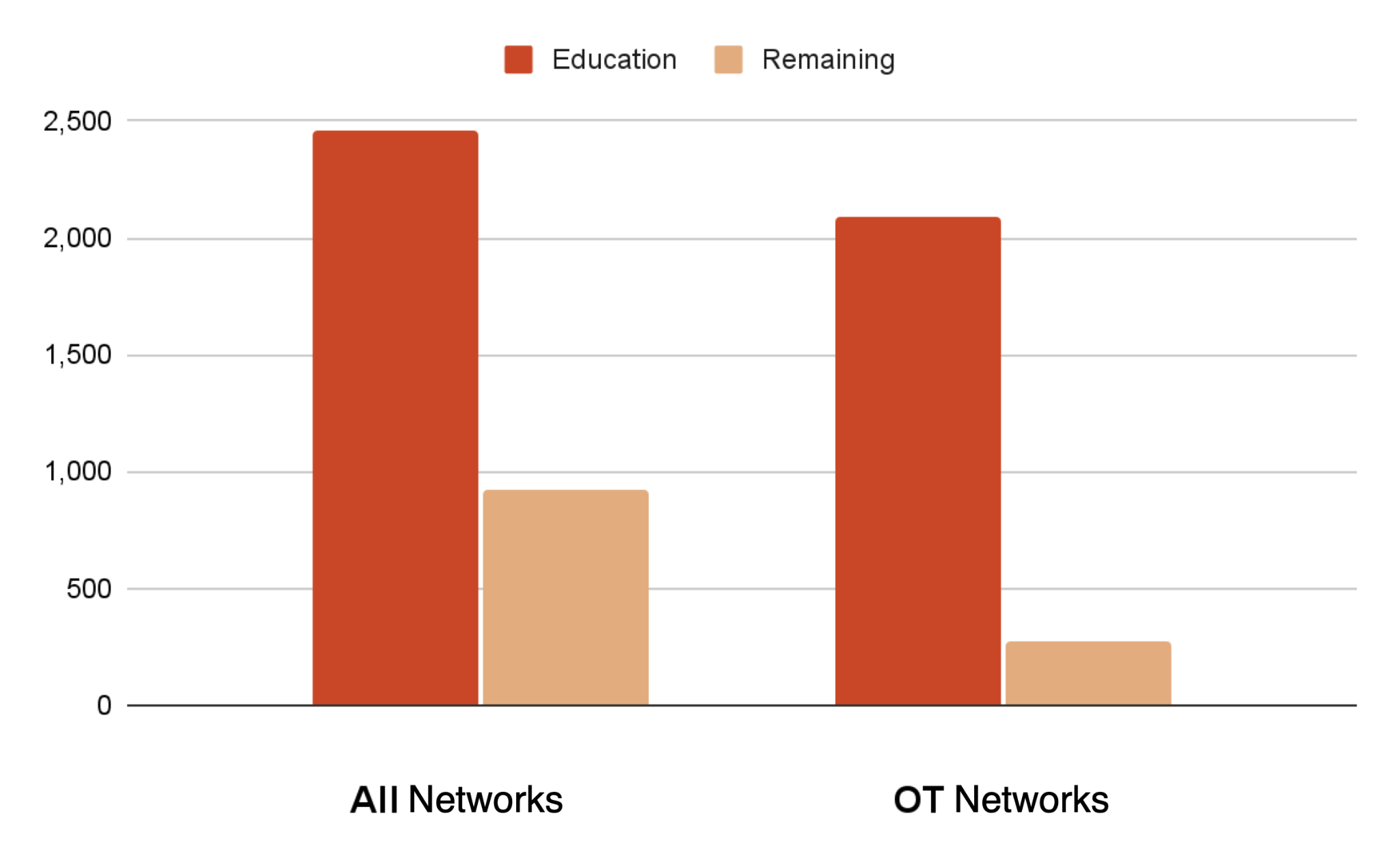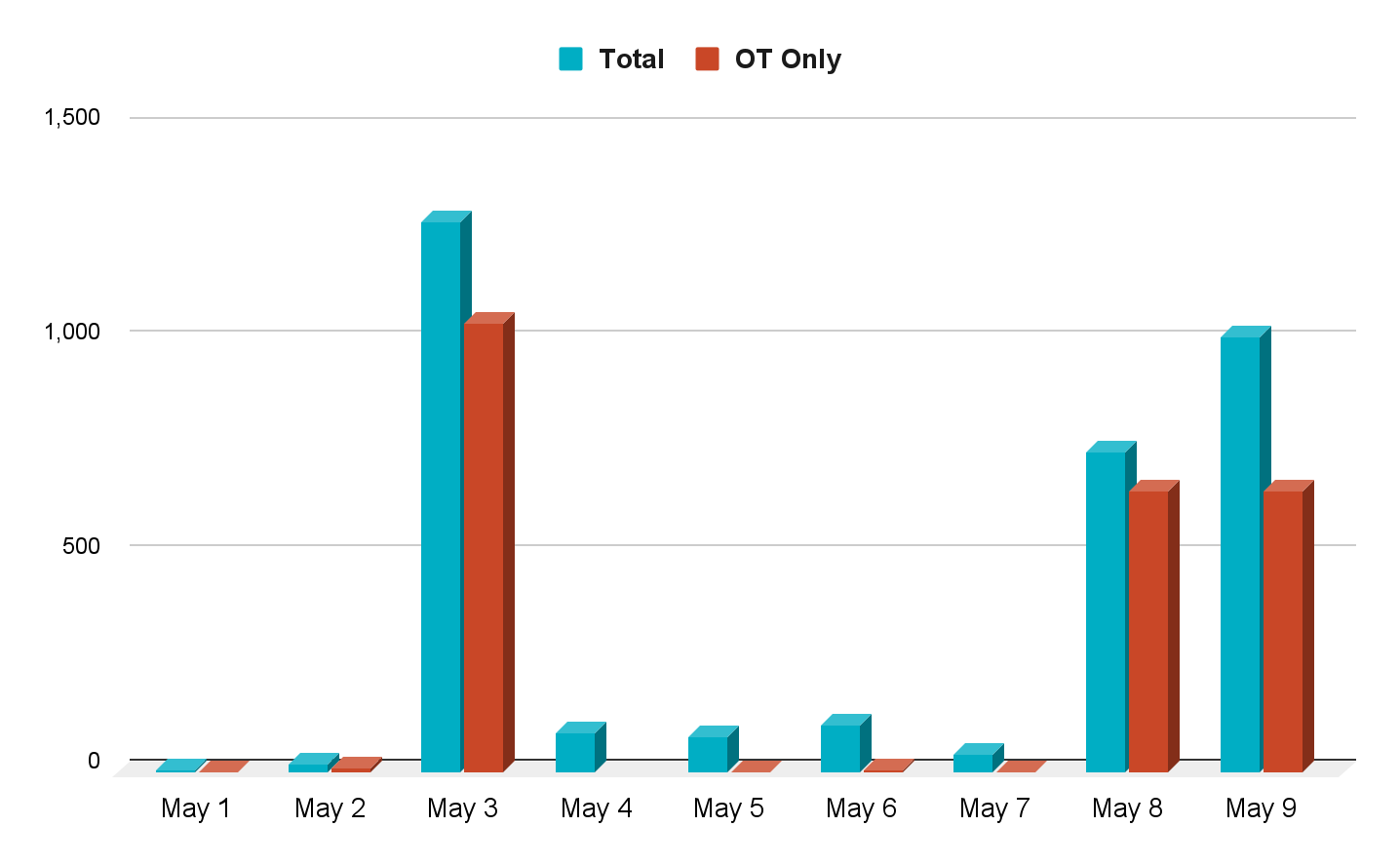Rigby, J. et al. The science performance of JWST as characterized in commissioning. Publ. Astron. Soc. Pac. 135, 048001 (2023).
Google Scholar
Kennicutt, R. C. & Evans, N. J. Star formation in the Milky Way and nearby galaxies. Annu. Rev. Astron. Astrophys. 50, 531–608 (2012).
Google Scholar
Carnall, A. C., McLure, R. J., Dunlop, J. S. & Davé, R. Inferring the star formation histories of massive quiescent galaxies with BAGPIPES: evidence for multiple quenching mechanisms. Mon. Not. R. Astron. Soc. 480, 4379–4401 (2018).
Google Scholar
Carnall, A. C. et al. The VANDELS survey: the star-formation histories of massive quiescent galaxies at 1.0 < z < 1.3. Mon. Not. R. Astron. Soc. 490, 417–439 (2019).
Google Scholar
Kroupa, P. On the variation of the initial mass function. Mon. Not. R. Astron. Soc. 322, 231–246 (2001).
Google Scholar
Leja, J., Carnall, A. C., Johnson, B. D., Conroy, C. & Speagle, J. S. How to measure galaxy star formation histories. II. Nonparametric models. Astrophys. J. 876, 3 (2019).
Google Scholar
Pacifici, C. et al. The evolution of star formation histories of quiescent galaxies. Astrophys. J. 832, 79 (2016).
Google Scholar
Carnall, A. C. et al. A massive quiescent galaxy at redshift 4.658. Nature 619, 716–719 (2023).
Google Scholar
de Graaff, A. et al. Efficient formation of a massive quiescent galaxy at redshift 4.9. Nat. Astron. 9, 280–292 (2025).
Weibel, A. et al. RUBIES reveals a massive quiescent galaxy at z = 7.3. Astrophys. J. 983, 11 (2025).
Maiolino, R. et al. A small and vigorous black hole in the early Universe. Nature 627, 59–63 (2024).
Google Scholar
Goulding, A. D. et al. UNCOVER: the growth of the first massive black holes from JWST/NIRSpec-spectroscopic redshift confirmation of an X-ray luminous AGN at z = 10.1. Astrophys. J. Lett. 955, L24 (2023).
Google Scholar
Zhang, H. et al. TRINITY IV: predictions for supermassive black holes at z ≳ 6. Mon. Not. R. Astron. Soc. 531, 4974–4989 (2024).
Scoggins, M. T. & Haiman, Z. Diagnosing the massive-seed pathway to high-redshift black holes: statistics of the evolving black hole to host galaxy mass ratio. Mon. Not. R. Astron. Soc. 531, 4584–4597 (2024).
Google Scholar
Li, W., Inayoshi, K., Onoue, M. & Toyouchi, D. The assembly of black hole mass and luminosity functions of high-redshift quasars via multiple accretion episodes. Astrophys. J. 950, 85 (2023).
Google Scholar
Davies, F. B., Hennawi, J. F. & Eilers, A.-C. Evidence for low radiative efficiency or highly obscured growth of z > 7 quasars. Astrophys. J. Lett. 884, L19 (2019).
Google Scholar
Eilers, A.-C. et al. EIGER VI. The correlation function, host halo mass and duty cycle of luminous quasars at z > 6. Astrophys. J. 974, 275 (2024).
Davies, R. I. et al. A close look at star formation around active galactic nuclei. Astrophys. J. 671, 1388–1412 (2007).
Google Scholar
Wild, V., Heckman, T. & Charlot, S. Timing the starburst-AGN connection. Mon. Not. R. Astron. Soc. 405, 933–947 (2010).
Google Scholar
Maiolino, R. et al. JADES: the diverse population of infant black holes at 4 < z < 11: merging, tiny, poor, but mighty. Astron. Astrophys. 691, A145 (2024).
Lupi, A., Quadri, G., Volonteri, M., Colpi, M. & Regan, J. A. Sustained super-Eddington accretion in high-redshift quasars. Astron. Astrophys. 686, A256 (2024).
Google Scholar
Tanaka, M. et al. Stellar velocity dispersion of a massive quenching galaxy at z = 4.01. Astrophys. J. Lett. 885, L34 (2019).
Google Scholar
Looser, T. J. et al. A recently quenched galaxy 700 million years after the Big Bang. Nature 629, 53–57 (2024).
Google Scholar
Kormendy, J. & Ho, L. C. Coevolution (or not) of supermassive black holes and host galaxies. Annu. Rev. Astron. Astrophys. 51, 511–653 (2013).
Google Scholar
Ito, K. et al. COSMOS2020: ubiquitous AGN activity of massive quiescent galaxies at 0 < z < 5 revealed by X-ray and radio stacking. Astrophys. J. 929, 53 (2022).
Google Scholar
Belli, S. et al. Star formation shut down by multiphase gas outflow in a galaxy at a redshift of 2.45. Nature 630, 54–58 (2024).
Google Scholar
D’Eugenio, F. et al. A fast-rotator post-starburst galaxy quenched by supermassive black-hole feedback at z = 3. Nat. Astron. 8, 1443–1456 (2024).
Arita, J. et al. Subaru high-z exploration of low-luminosity quasars (SHELLQs). XVIII. The dark matter halo mass of quasars at z ~ 6. Astrophys. J. 954, 210 (2023).
Google Scholar
Decarli, R. et al. An ALMA [C ii] survey of 27 quasars at z > 5.94. Astrophys. J. 854, 97 (2018).
Google Scholar
Walter, F. et al. ALMA 200 pc imaging of a z ~ 7 quasar reveals a compact, disk-like host galaxy. Astrophys. J. 927, 21 (2022).
Google Scholar
Matsuoka, Y. et al. Subaru high-z exploration of low-luminosity quasars (SHELLQs). I. Discovery of 15 quasars and bright galaxies at 5.7 < z < 6.9. Astrophys. J. 828, 26 (2016).
Google Scholar
Matsuoka, Y. et al. Subaru high-z exploration of low-luminosity quasars (SHELLQs). X. Discovery of 35 quasars and luminous galaxies at 5.7 ≤ z ≤ 7.0. Astrophys. J. 883, 183 (2019).
Google Scholar
Aihara, H. et al. The Hyper Suprime-Cam SSP Survey: overview and survey design. Publ. Astron. Soc. Jpn 70, S4 (2018).
Ding, X. et al. Detection of stellar light from quasar host galaxies at redshifts above 6. Nature 621, 51–55 (2023).
Google Scholar
Brammer, G. msaexp: NIRSpec analysis tools (0.6.17). Zenodo https://doi.org/10.5281/zenodo.8319596 (2023).
Ding, X. et al. The mass relations between supermassive black holes and their host galaxies at 1 < z < 2 HST-WFC3. Astrophys. J. 888, 37 (2020).
Google Scholar
Birrer, S. et al. Lenstronomy II: a gravitational lensing software ecosystem. J. Open Source Softw. 6, 3283 (2021).
Google Scholar
Li, J. et al. Synchronized coevolution between supermassive black holes and galaxies over the last seven billion years as revealed by Hyper Suprime-Cam. Astrophys. J. 922, 142 (2021).
Google Scholar
Tanaka, T. S. et al. The MBH–M* relation up to z ~ 2 through decomposition of COSMOS-Web NIRCam images. Astrophys. J. 979, 215 (2025).
Ito, K. et al. Size–stellar mass relation and morphology of quiescent galaxies at z ≥ 3 in public JWST fields. Astrophys. J. 964, 192 (2024).
Google Scholar
Ding, X. et al. SHELLQs-JWST unveils the host galaxies of twelve quasars at z > 6. Preprint at https://arxiv.org/abs/2505.03876 (2025).
Fu, Y. QSOFITMORE: a Python package for fitting UV-optical spectra of quasars. Zenodo https://doi.org/10.5281/zenodo.5810042 (2021).
Selsing, J., Fynbo, J. P. U., Christensen, L. & Krogager, J.-K. An X-Shooter composite of bright 1 < z < 2 quasars from UV to infrared. Astron. Astrophys. 585, A87 (2016).
Google Scholar
Goto, T. et al. Hδ-strong galaxies in the Sloan Digital Sky Survey. I. The catalog. Publ. Astron. Soc. Jpn 55, 771–787 (2003).
Google Scholar
Wu, P.-F. Ejective feedback as a quenching mechanism in the first 1.5 billion years of the Universe: detection of neutral gas outflow in a z = 4 recently quenched galaxy. Astrophys. J. 978, 131 (2025).
Curtis-Lake, E. et al. Spectroscopic confirmation of four metal-poor galaxies at z = 10.3–13.2. Nat. Astron. 7, 622–632 (2023).
Google Scholar
Inayoshi, K. & Maiolino, R. Extremely dense gas around little red dots and high-redshift AGNs: a non-stellar origin of the Balmer break and absorption features. Astrophys. J. Lett. 980, L27 (2025).
Bruzual, G. & Charlot, S. Stellar population synthesis at the resolution of 2003. Mon. Not. R. Astron. Soc. 344, 1000–1028 (2003).
Google Scholar
Chevallard, J. & Charlot, S. Modelling and interpreting spectral energy distributions of galaxies with BEAGLE. Mon. Not. R. Astron. Soc. 462, 1415–1443 (2016).
Google Scholar
Falcón-Barroso, J. et al. An updated MILES stellar library and stellar population models. Astron. Astrophys. 532, A95 (2011).
Calzetti, D. et al. The dust content and opacity of actively star-forming galaxies. Astrophys. J. 533, 682–695 (2000).
Google Scholar
Nakajima, K. et al. JWST census for the mass-metallicity star formation relations at z = 4–10 with self-consistent flux calibration and proper metallicity calibrators. Astrophys. J. Suppl. Ser. 269, 33 (2023).
Google Scholar
Greene, J. E. & Ho, L. C. Measuring stellar velocity dispersions in active galaxies. Astrophys. J. 641, 117–132 (2006).
Google Scholar
Cappellari, M. Full spectrum fitting with photometry in PPXF: stellar population versus dynamical masses, non-parametric star formation history and metallicity for 3200 LEGA-C galaxies at redshift z ≈ 0.8. Mon. Not. R. Astron. Soc. 526, 3273–3300 (2023).
Google Scholar
Conroy, C., Gunn, J. E. & White, M. The propagation of uncertainties in stellar population synthesis modeling. I. The relevance of uncertain aspects of stellar evolution and the initial mass function to the derived physical properties of galaxies. Astrophys. J. 699, 486–506 (2009).
Google Scholar
Conroy, C. & Gunn, J. E. The propagation of uncertainties in stellar population synthesis modeling. III. Model calibration, comparison, and evaluation. Astrophys. J. 712, 833–857 (2010).
Google Scholar
Matsuoka, Y. et al. Subaru high-z exploration of low-luminosity quasars (SHELLQs). V. Quasar luminosity function and contribution to cosmic reionization at z = 6. Astrophys. J. 869, 150 (2018).
Google Scholar
Eracleous, M., Lewis, K. T. & Flohic, H. M. L. G. Double-peaked emission lines as a probe of the broad-line regions of active galactic nuclei. New Astron. Rev. 53, 133–139 (2009).
Google Scholar
Ward, C. et al. Panic at the ISCO: time-varying double-peaked broad lines from evolving accretion disks are common among optically variable AGNs. Astrophys. J. 961, 172 (2024).
Google Scholar
Chen, K. & Halpern, J. P. Structure of line-emitting accretion disks in active galactic nuclei: ARP 102B. Astrophys. J. 344, 115 (1989).
Google Scholar
Luo, B. et al. Discovery of the most distant double-peaked emitter at z = 1.369. Astrophys. J. 695, 1227–1232 (2009).
Google Scholar
Strateva, I. V. et al. Double-peaked low-ionization emission lines in active galactic nuclei. Astron. J. 126, 1720–1749 (2003).
Google Scholar
Xu, D. & Komossa, S. Narrow double-peaked emission lines of SDSS J131642.90+175332.5: signature of a single or a binary AGN in a merger, jet-cloud interaction, or unusual narrow-line region geometry. Astrophys. J. Lett. 705, L20–L24 (2009).
Google Scholar
Smith, K. L. et al. A search for binary active galactic nuclei: double-peaked [O iii] AGNs in the Sloan Digital Sky Survey. Astrophys. J. 716, 866–877 (2010).
Google Scholar
Übler, H. et al. GA-NIFS: JWST discovers an offset AGN 740 million years after the big bang. Mon. Not. R. Astron. Soc. 531, 355–365 (2024).
Google Scholar
Bischetti, M. et al. The WISSH quasars project. I. Powerful ionised outflows in hyper-luminous quasars. Astron. Astrophys. 598, A122 (2017).
Marshall, M. A. et al. GA-NIFS: black hole and host galaxy properties of two z ≃ 6.8 quasars from the NIRSpec IFU. Astron. Astrophys. 678, A191 (2023).
Yang, J. et al. A spectroscopic survey of biased halos in the reionization era (ASPIRE): a first look at the rest-frame optical spectra of z > 6.5 quasars using JWST. Astrophys. J. Lett. 951, L5 (2023).
Google Scholar
Vestergaard, M. & Peterson, B. M. Determining central black hole masses in distant active galaxies and quasars. II. Improved optical and UV scaling relationships. Astrophys. J. 641, 689–709 (2006).
Google Scholar
Richards, G. T. et al. Spectral energy distributions and multiwavelength selection of type 1 quasars. Astrophys. J. Suppl. Ser. 166, 470–497 (2006).
Google Scholar
Greene, J. E. & Ho, L. C. Estimating black hole masses in active galaxies using the Hα emission line. Astrophys. J. 630, 122–129 (2005).
Google Scholar
Salmon, B. et al. The relation between star formation rate and stellar mass for galaxies at 3.5 ≤ z ≤ 6.5 in CANDELS. Astrophys. J. 799, 183 (2015).
Google Scholar
Izumi, T. et al. Subaru high-z exploration of low-luminosity quasars (SHELLQs). XIII. Large-scale feedback and star formation in a low-luminosity quasar at z = 7.07 on the local black hole to host mass relation. Astrophys. J. 914, 36 (2021).
Google Scholar
Schreiber, C. et al. Near infrared spectroscopy and star-formation histories of 3 ≤ z ≤ 4 quiescent galaxies. Astron. Astrophys. 618, A85 (2018).
Valentino, F. et al. Quiescent galaxies 1.5 billion years after the Big Bang and their progenitors. Astrophys. J. 889, 93 (2020).
Google Scholar
Forrest, B. et al. The massive ancient galaxies at z > 3 near-infrared (MAGAZ3NE) survey: confirmation of extremely rapid star formation and quenching timescales for massive galaxies in the early Universe. Astrophys. J. 903, 47 (2020).
Google Scholar
Carnall, A. C. et al. The JWST EXCELS survey: too much, too young, too fast? Ultra-massive quiescent galaxies at 3 < z < 5. Mon. Not. R. Astron. Soc. 534, 325–348 (2024).
Nanayakkara, T. et al. A population of faint, old, and massive quiescent galaxies at 3 < z < 4 revealed by JWST NIRSpec Spectroscopy. Sci. Rep. 14, 3724 (2024).
Google Scholar
Kakimoto, T. et al. A massive quiescent galaxy in a group environment at z = 4.53. Astrophys. J. 963, 49 (2024).
Google Scholar
Glazebrook, K. et al. A massive galaxy that formed its stars at z ≈ 11. Nature 628, 277–281 (2024).
Google Scholar
Wang, B. et al. RUBIES: evolved stellar populations with extended formation histories at z ~ 7–8 in candidate massive galaxies identified with JWST/NIRSpec. Astrophys. J. Lett. 969, L13 (2024).
Kokorev, V. et al. Silencing the giant: evidence of active galactic nucleus feedback and quenching in a little red dot at z = 4.13. Astrophys. J. 975, 178 (2024).
Labbe, I. et al. An unambiguous AGN and a Balmer break in an ultraluminous little red dot at z = 4.47 from ultradeep UNCOVER and all the little things spectroscopy. Preprint at https://arxiv.org/abs/2412.04557 (2024).
Stone, M. A., Lyu, J., Rieke, G. H. & Alberts, S. Detection of the low-stellar-mass host galaxy of a z = 6.25 quasar with JWST. Astrophys. J. 953, 180 (2023).
Google Scholar
Stone, M. A., Lyu, J., Rieke, G. H., Alberts, S. & Hainline, K. N. Undermassive host galaxies of five z ~ 6 luminous quasars detected with JWST. Astrophys. J. 964, 90 (2024).
Google Scholar
Yue, M. et al. EIGER. V. Characterizing the host galaxies of luminous quasars at z ≳ 6. Astrophys. J. 966, 176 (2024).
Google Scholar
Matsuoka, Y. et al. The Sloan Digital Sky Survey reverberation mapping project: post-starburst signatures in quasar host galaxies at z > 1. Astrophys. J. 811, 91 (2015).
Google Scholar
